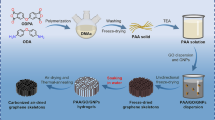Abstract
Stable ethylene glycol (EG)-based nanofluids containing graphene nanoplatelets (GnPs) were prepared by intensive ultrasonication without any surfactant. The structural properties of the commercially produced GnPs were confirmed using the nitrogen gas adsorption method, Fourier transform infrared spectroscopy, X-ray diffraction method, Raman spectroscopy, and high-resolution transmission electron microscopy. After ultrasound irradiation, the GnP aggregates were broken into thinner and smaller-sized nanosheets, which is beneficial for a stable dispersion. The ultrasonic-treated GnPs showed a constant value of thermal conductivity enhancement, k/k o (= 1.127 ± 0.002) at 2 vol% in the temperature range of 10–90 °C. From the analyses of the thermal conductivities of the GnP nanofluids as functions of GnP concentration and temperature, it was concluded that the thermal conductivity increased as the GnP concentration and the temperature increased. Furthermore, the experimentally measured thermal conductivities of the EG-based GnP nanofluids were much higher than the theoretically calculated values based on the Hamilton–Crosser correlation, which is due to higher specific surface area and two-dimensional structures of the GnPs.






Similar content being viewed by others
References
Novoselov KS, Geim AK, Morozov SV et al (2004) Electric field effect in atomically thin carbon films. Science 306:666
Wang G, Yang J, Park JS et al (2008) Facile synthesis and characterization of graphene nanosheets. J Phys Chem C 112:8192
Geng Y, Wang SJ, Kim JK (2009) Preparation of graphite nanoplatelets and graphene sheets. J Colloid Interface Sci 336:592
Baby TT, Ramaprabhu S (2010) Investigation of thermal and electrical conductivity of graphene based nanofluids. J Appl Phys 108:124308
Teng CC, Ma CCM, Lu CH et al (2011) Thermal conductivity and structure of non-covalent functionalized graphene/epoxy composites. Carbon 49:5107
Yu W, Xie H, Wang X, Wang X (2011) Significant thermal conductivity enhancement for nanofluids containing graphene nanosheets. Phys Lett A 375:1323
Zhong WR, Zhang MP, Ai BQ, Zheng DQ (2011) Chirality and thickness-dependent thermal conductivity of few-layer graphene: a molecular dynamics study. Appl Phys Lett 98:113107
Sun B, Wang B, Su D et al (2012) Graphene nanosheets as cathode catalysts for lithium-air batteries with an enhanced electrochemical performance. Carbon 50:727
Sridhar V, Jeon JH, Oh IK (2010) Synthesis of graphene nano-sheets using eco-friendly chemicals and microwave radiation. Carbon 48:2953
Zhang W, He W, Jing X (2010) Preparation of a stable graphene dispersion with high concentration by ultrasound. J Phys Chem B 114:10368
Barrett EP, Joyner LG, Halenda PP (1951) The determination of pore volume and area distributions in porous substances. I. Computations from nitrogen isotherms. J Am Chem Soc 73:373
Webb PA, Orr C (1997) Analytical methods in fine particle technology. Micromeritics Instrument Corp, Norcross, GA
Lee GJ, Pyun SI (2007) Modern aspects of electrochemistry, vol 41. Springer, New York
Sing KSW, Everett DH, Haul RAW et al (1985) Reporting physisorption data for gas/solid systems with special reference to the determination of surface area and porosity. Pure Appl Chem 57:603
Kruk M, Jaroniec M (2001) Gas adsorption characterization of ordered organic–inorganic nanocomposite materials. Chem Mater 13:3169
Shen J, Hu Y, Shi M et al (2009) Fast and facile preparation of graphene oxide and reduced graphene oxide nanoplatelets. Chem Mater 21:3514
Zhu C, Guo S, Fang Y, Dong S (2010) Reducing sugar: new functional molecules for the green synthesis of graphene nanosheets. ACS Nano 4:2429
Garg P, Alvarado JL, Marsh C et al (2009) An experimental study on the effect of ultrasonication on viscosity and heat transfer performance of multi-wall carbon nanotube-based aqueous nanofluids. Int J Heat Mass Transf 52:5090
Krause B, Mende M, Pötschke P, Petzold G (2010) Dispersability and particle size distribution of CNTs in an aqueous surfactant dispersion as a function of ultrasonic treatment time. Carbon 48:2746
Karthikeyan NR, Philip J, Raj B (2008) Effect of clustering on the thermal conductivity of nanofluids. Mater Chem Phys 109:50
Kim CK, Lee GJ, Rhee CK (2012) A study on heat transfer characteristics of spherical and fibrous alumina nanofluids. Thermochim Acta 542:33
Lee GJ, Kim CK, Lee MK et al (2012) Thermal conductivity enhancement of ZnO nanofluid using a one-step physical method. Thermochim Acta 542:24
Hamilton RL, Crosser OK (1962) Thermal conductivity of heterogeneous two-component systems. Ind Eng Chem Fundam 1:187
Acknowledgements
This work was supported by the Korea Atomic Energy Research Institute (KAERI) Project, Republic of Korea.
Author information
Authors and Affiliations
Corresponding author
Rights and permissions
About this article
Cite this article
Lee, GJ., Rhee, C.K. Enhanced thermal conductivity of nanofluids containing graphene nanoplatelets prepared by ultrasound irradiation. J Mater Sci 49, 1506–1511 (2014). https://doi.org/10.1007/s10853-013-7831-6
Received:
Accepted:
Published:
Issue Date:
DOI: https://doi.org/10.1007/s10853-013-7831-6




